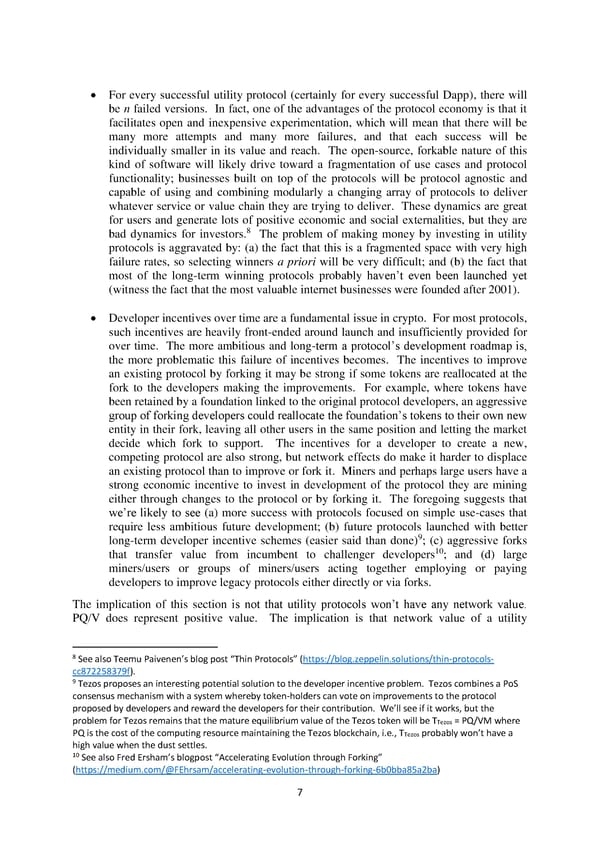• For every successful utility protocol (certainly for every successful Dapp), there will be n failed versions. In fact, one of the advantages of the protocol economy is that it facilitates open and inexpensive experimentation, which will mean that there will be many more attempts and many more failures, and that each success will be individually smaller in its value and reach. The open-source, forkable nature of this kind of software will likely drive toward a fragmentation of use cases and protocol functionality; businesses built on top of the protocols will be protocol agnostic and capable of using and combining modularly a changing array of protocols to deliver whatever service or value chain they are trying to deliver. These dynamics are great for users and generate lots of positive economic and social externalities, but they are bad dynamics for investors.8 The problem of making money by investing in utility protocols is aggravated by: (a) the fact that this is a fragmented space with very high failure rates, so selecting winners a priori will be very difficult; and (b) the fact that most of the long-term winning protocols probably haven’t even been launched yet (witness the fact that the most valuable internet businesses were founded after 2001). • Developer incentives over time are a fundamental issue in crypto. For most protocols, such incentives are heavily front-ended around launch and insufficiently provided for over time. The more ambitious and long-term a protocol’s development roadmap is, the more problematic this failure of incentives becomes. The incentives to improve an existing protocol by forking it may be strong if some tokens are reallocated at the fork to the developers making the improvements. For example, where tokens have been retained by a foundation linked to the original protocol developers, an aggressive group of forking developers could reallocate the foundation’s tokens to their own new entity in their fork, leaving all other users in the same position and letting the market decide which fork to support. The incentives for a developer to create a new, competing protocol are also strong, but network effects do make it harder to displace an existing protocol than to improve or fork it. Miners and perhaps large users have a strong economic incentive to invest in development of the protocol they are mining either through changes to the protocol or by forking it. The foregoing suggests that we’re likely to see (a) more success with protocols focused on simple use-cases that require less ambitious future development; (b) future protocols launched with better long-term developer incentive schemes (easier said than done)9; (c) aggressive forks that transfer value from incumbent to challenger developers10; and (d) large miners/users or groups of miners/users acting together employing or paying developers to improve legacy protocols either directly or via forks. The implication of this section is not that utility protocols won’t have any network value. PQ/V does represent positive value. The implication is that network value of a utility 8 See also Teemu Paivenen’s blog post “Thin Protocols” (https://blog.zeppelin.solutions/thin-protocols- cc872258379f). 9 Tezos proposes an interesting potential solution to the developer incentive problem. Tezos combines a PoS consensus mechanism with a system whereby token-holders can vote on improvements to the protocol proposed by developers and reward the developers for their contribution. We’ll see if it works, but the problem for Tezos remains that the mature equilibrium value of the Tezos token will be TTezos = PQ/VM where PQ is the cost of the computing resource maintaining the Tezos blockchain, i.e., T probably won’t have a Tezos high value when the dust settles. 10 See also Fred Ersham’s blogpost “Accelerating Evolution through Forking” (https://medium.com/@FEhrsam/accelerating-evolution-through-forking-6b0bba85a2ba) 7
 Investor’s Take on Cryptoassets by John Pfeffer Page 6 Page 8
Investor’s Take on Cryptoassets by John Pfeffer Page 6 Page 8